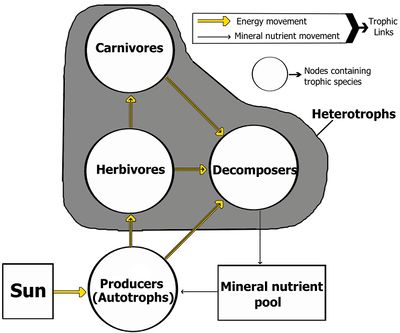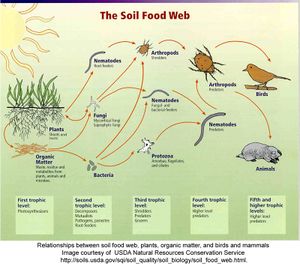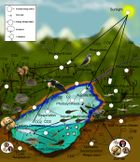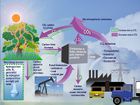شبكة غذائية
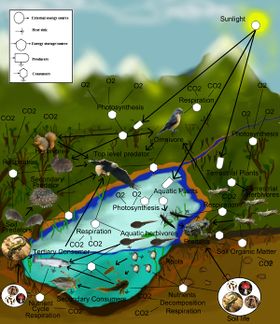
الشبكة الغذائية Food web، هي التداخل المعقد في النظام الغذائي، والذي ينشأ عن تداخل أكثر من سلسلة غذائية مع بعضها، مثل الارتباط بين السلاسل الغذائية في بركة صغيرة pond ومرج meadow مجاور.[1]
تصنيف الشبكة الغذائية
مستويات التغذية
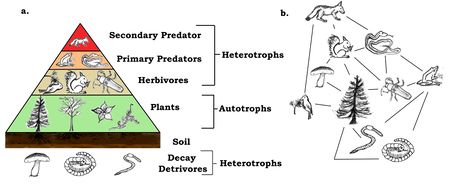
A trophic pyramid (a) and a simplified community food web (b) illustrating ecological relations among creatures that are typical of a northern Boreal terrestrial ecosystem. The trophic pyramid roughly represents the biomass (usually measured as total dry-weight) at each level. Plants generally have the greatest biomass. Names of trophic categories are shown to the left of the pyramid. Some ecosystems, such as many wetlands, do not organize as a strict pyramid, because aquatic plants are not as productive as long-lived terrestrial plants such as trees. Ecological trophic pyramids are typically one of three kinds: 1) pyramid of numbers, 2) pyramid of biomass, or 3) pyramid of energy.[2]
التغذية الديناميكية
تدفق الطاقة والكتلة الحيوية
السلسلة الغذائية
الهرم البيئي
تدفق المواد وإعادة التدوير
أنواع الشبكات الغذائية

Paleoecological studies can reconstruct fossil food-webs and trophic levels. Primary producers form the base (red spheres), predators at top (yellow spheres), the lines represent feeding links. Original food-webs (left) are simplified (left) by aggregating groups feeding on common prey into coarser grained trophic species.[3]
Detrital web
الشبكات الغذائية الكمية
التعقيد والاستقرار
تاريخ الشبكات الغذائية
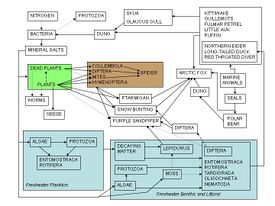
Victor Summerhayes and Charles Elton's 1923 food web of Bear Island (Arrows point to an organism being consumed by another organism).
انظر أيضا
- Antipredator adaptations
- Apex predator
- Balance of Nature
- تنوع حيوي
- Biogeochemical cycle
- Consumer-resource systems
- Ecological network
- نظام غذائي
- Food web of the San Francisco Estuary
- Microbial food web
- Natural environment
- List of feeding behaviours
- Soil food web
- Trophic ecology of kelp forests
- Trophic relationships in lakes
- Trophic relationships in rivers
المصادر
- ^ عبد الجليل هويدي، محمد أحمد هيكل (2004). أساسيات الجيولوجيا التاريخية. مكتبة الدار العربية للكتب.
- ^ Odum, E. P.; Barrett, G. W. (2005). Fundamentals of Ecology (5th ed.). Brooks/Cole, a part of Cengage Learning. ISBN 0-534-42066-4.
- ^ خطأ استشهاد: وسم
<ref>غير صحيح؛ لا نص تم توفيره للمراجع المسماةDunne08
قراءات للإستزادة
- Cohen, Joel E. (1978). Food webs and niche space. Monographs in Population Biology. Vol. 11. Princeton, NJ: Princeton University Press. pp. xv+1–190. ISBN 978-0-691-08202-8.
{{cite book}}: External link in|publisher=|ref=harv(help)
This article contains content from Wikimedia licensed under CC BY-SA 4.0. Please comply with the license terms.
